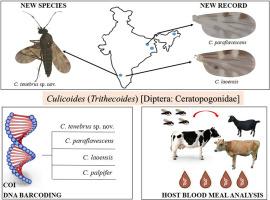New species, country records, DNA barcoding and host blood meal analysis of some Indian species of Culicoides Latreille subgenus Trithecoides Wirth and Hubert (Diptera: Ceratopogonidae)
IF 2.5
3区 医学
Q2 PARASITOLOGY
引用次数: 0
Abstract
Light trap collections from four states in India revealed the presence of four species belonging to Culicoides (Trithecoides). Included were a new species from the macfiei group, Culicoides tenebrus sp. nov., which is diagnosed with a dark mid-knee and a yellow scutum featuring a dark anterior quarter, two new country records for India: Culicoides paraflavescens Wirth and Hubert, 1959, and Culicoides laoensis Howarth, 1985, and some variants of the widely distributed species Culicoides palpifer Das Gupta and Ghosh, 1956. Collections contained blood-fed specimens of each of these species, and host blood meal analysis using 16S rRNA revealed that all specimens had fed on cattle. DNA barcodes obtained from some specimens of these species were analysed along with other species from Culicoides (Trithecoides), and a phylogenetic tree based on these sequences supported the status of each of these species. Considerable variation was observed within C. palpifer both in morphology and DNA barcodes, suggesting that this species requires some taxonomic revision. The apparent preference of these four species for cattle hosts suggests that studies into their vector potential are warranted; however, the status of the species of Trithecoides requires clarification before any vector potential studies.

印度库蠓亚属(Trithecoides Wirth和Hubert)部分新种、国家记录、DNA条形码和宿主血粉分析(双翅目:蠓科)
从印度4个邦收集的捕光器显示有4种库蠓属(Trithecoides)。其中包括来自macfiei类群的一个新种——黄斑库蚊(Culicoides tenebrus) sp11 .,诊断为膝中黑色,前四分之一呈黄色,印度的两个新国家记录:副黄斑库蚊(Culicoides paraflavescens Wirth和Hubert, 1959年)和老挝库蚊(Culicoides laoensis Howarth, 1985年),以及广泛分布的palpifer库蚊(Culicoides Das Gupta和Ghosh, 1956年)的一些变种。采集的标本中含有这些物种的血液喂养标本,使用16S rRNA对宿主血粉进行分析显示,所有标本都以牛为食。从这些物种的一些标本中获得的DNA条形码与库蠓属(三蠓属)的其他物种一起进行了分析,并基于这些序列建立了一个系统发育树,支持了这些物种的地位。在形态学和DNA条形码上观察到相当大的差异,表明该物种需要进行一些分类修订。这四种物种对牛宿主的明显偏好表明,有必要对它们的载体潜力进行研究;然而,在进行任何潜在媒介研究之前,需要澄清三蠓的物种状况。
本文章由计算机程序翻译,如有差异,请以英文原文为准。
求助全文
约1分钟内获得全文
求助全文
来源期刊

Acta tropica
医学-寄生虫学
CiteScore
5.40
自引率
11.10%
发文量
383
审稿时长
37 days
期刊介绍:
Acta Tropica, is an international journal on infectious diseases that covers public health sciences and biomedical research with particular emphasis on topics relevant to human and animal health in the tropics and the subtropics.
 求助内容:
求助内容: 应助结果提醒方式:
应助结果提醒方式:


